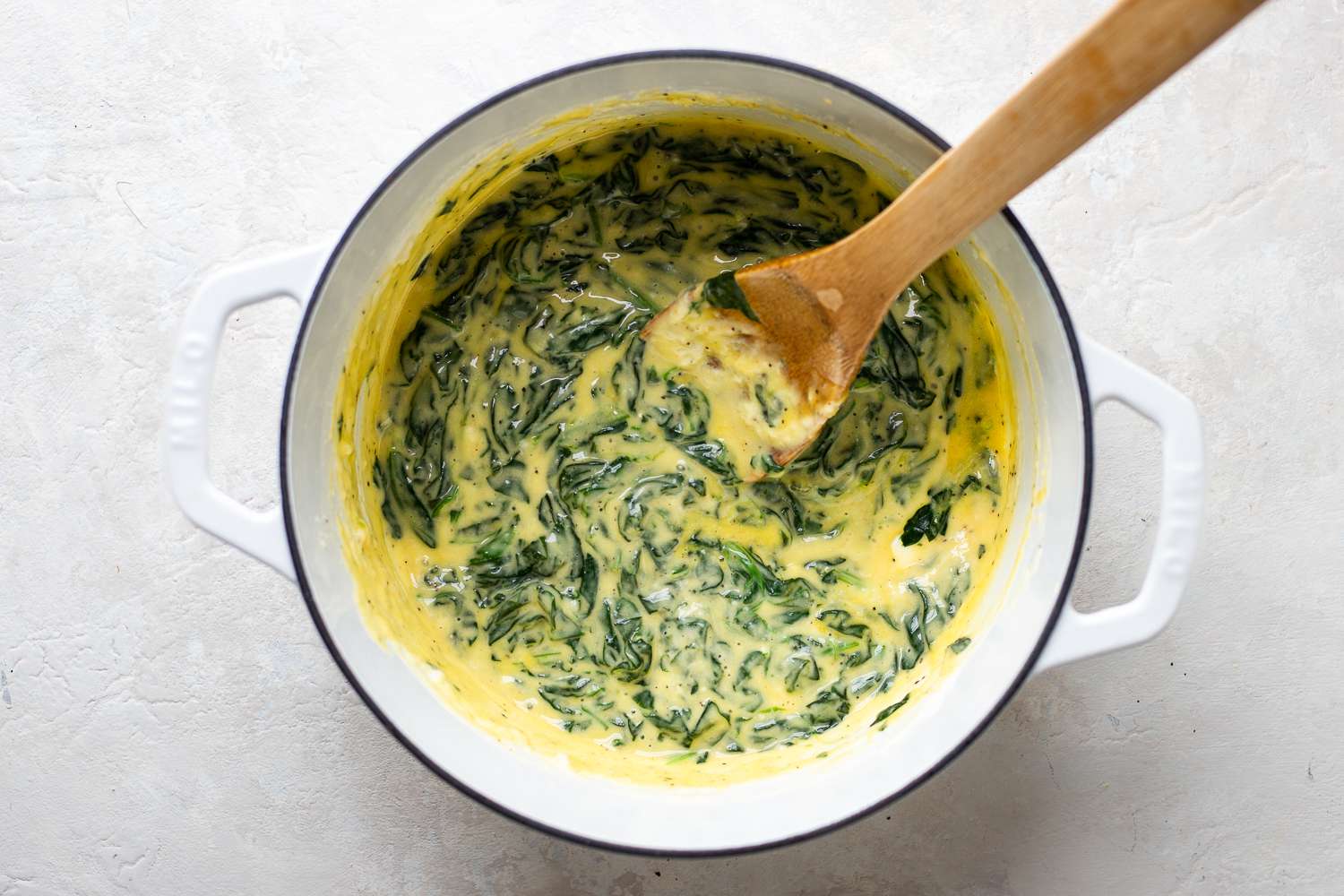Serves 4 to 6
• 2 lbs. fresh spinach
• 2 tsp. salt
• ⅓ cup chopped green onions
• 1 Tbs. olive oil
• ½ tsp. cider vinegar
• ¼ tsp. dried dill weed
• 3 Tbs. butter
• 4 Tbs. flour
• 1 cup hot milk
• pinch of nutmeg
• pinch of cayenne pepper
• 6 egg yolks
• 3 Tbs. grated Parmesan cheese
• black pepper to taste
• 7 egg whites
• pinch of cream of tartar
Garnish
• Hollandaise Sauce or Mornay Sauce
1. Wash and trim the spinach and toss the leaves with 1½ teaspoons of salt. Cook the spinach leaves in just the water that clings to them, tossing constantly over medium heat, until they are wilted and tender. Drain the spinach thoroughly and chop it finely.
2. Sauté the green onions in the olive oil until they are soft, then stir in the chopped spinach, cider vinegar, and dill weed.
3. Melt the butter in a heavy-bottomed saucepan and stir in the flour. Cook the roux over very low heat for several minutes, stirring often, then whisk in the hot milk. Cook the sauce until it thickens, season it with a little nutmeg and cayenne, then remove it from the heat and beat in the egg yolks, one by one. Return the sauce to very low heat, add the Parmesan cheese, and stir for about 2 to 3 minutes. Remove it from the heat and stir in the spinach mixture, seasoning it with the remaining ½ teaspoon salt and a little black pepper.
4. Beat the egg whites with a pinch of cream of tartar until they hold stiff peaks. Stir ¼ of the beaten egg whites into the spinach sauce, then fold in the remaining egg whites.
5. Pile the mixture into a buttered 2-quart soufflé dish or a 1½-quart soufflé dish prepared with a collar. Bake in a preheated 350-degree oven for 35 to 40 minutes and serve with Hollandaise Sauce or Mornay Sauce.
MAKING OMELETS
A good omelet is a wonderful thing and can play a fine role at breakfast, lunch, or even dinner. Unfortunately, it is difficult to get good omelets in most American restaurants, which is all the more reason to perfect your skill at preparing them.
Among the simplest of all foods in their composition, omelets require a certain amount of practice and a light touch in their preparation. If you are ready to invest a little time, though, and to eat scrambled eggs when those first efforts don’t result in perfection, there is no reason why you shouldn’t soon master the art and turn out tender, golden omelets every time, as pretty to look at as they are good to eat.
The first requirement for making a good omelet is to use good ingredients, and that means fresh eggs and plenty of real butter. (There was a dieters’ fad, which seems to be passing off, I’m grateful to notice, for cooking eggs with little or no butter in a “nonstick” skillet, a thoroughly barbaric idea.) In addition to the eggs and butter, you will only want some salt and pepper, and perhaps just a bit of milk or cream, but that is strictly a matter of preference. Those are the ingredients of a plain omelet, and you can make that plain omelet as elaborate as you like with any of a great variety of fillings and sauces.
The equipment is simple as well. Every kitchen has mixing bowls and a whisk or eggbeater, but pay attention to the pan. An omelet pan should have a heavy bottom and gently sloping or curved sides—a properly seasoned cast-iron or a Teflon pan. One more thing is needed to make the whole operation much easier, and that is a long, narrow, and flexible spatula.
To make an individual omelet, two eggs are generally sufficient, but three can be used if the appetite warrants it. Beat the eggs briefly in a bowl with a pinch of salt and a smaller pinch of pepper, as well as a dash of milk or cream if you like. Heat an 8- or 9-inch omelet pan and melt about 1 tablespoon of butter in it, swirling the butter all over the bottom of the pan. When the butter has melted and foamed and the foam has begun to subside, set a medium flame, pour in the beaten eggs, and tilt the pan around gently so that the eggs spread evenly over the bottom. In a moment, the eggs will begin to set. When they do, run the spatula once around the edge of the omelet to loosen it and shake the pan a bit. Then start carefully lifting the edges with your spatula and tilting the pan to let the uncooked eggs on top run to the bottom.
In less than a minute, the omelet will be nearly done. Give the pan another quick shake to keep the eggs from sticking. The top of the omelet, at this point, should be moist but not runny. If you are filling your omelet, spoon in some of the prepared filling now. Then slip a spatula under one side and fold it over the other. Leave the omelet in the pan just a few seconds more before sliding it out onto a warm plate. The omelet should be golden in color and tender and creamy inside. And it must be served immediately!
The commonest pitfall in making an omelet is overcooking the eggs, so do move quickly when they are starting to set. Overcooked eggs are tough and rubbery, even less acceptable than overcooked vegetables.
An omelet large enough for two can be made the same way, just by doubling the ingredients and using a slightly larger pan. Smaller omelets, however, are a great deal easier to handle if you’re just beginning, and so I advise starting with the individual sizes and moving on to larger ones when you’re an experienced hand.
Because omelets take so little time to prepare, they are an ideal dish for impromptu meals, and because eggs are so democratic in the way they successfully associate with nearly every other kind of edible, you can make an omelet to fit practically any taste or mood. Omelets with cheese, with vegetables, with hollandaise sauce, or with tomato sauce are all justly popular, but don’t ignore the possibilities of sweet omelets either. A delicious dessert or elegant brunch omelet can be made by using marmalade or sautéed apple slices as a filling, for example.








